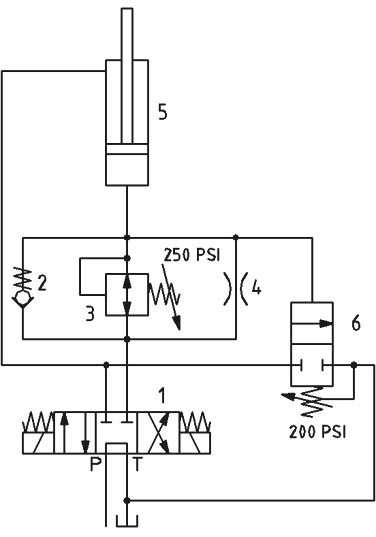How to control decompression in hydraulic press circuits |
|
One of our readers wrote to me recently regarding the following problem:
"I have a problem with a large garbage compactor. Each and every time the valve cycles the hydraulic cylinder, there is a loud bang. What are the possible causes?"
Assuming this noise is being generated by the hydraulics, i.e. it is not a symptom of a mechanical problem, its likely cause is uncontrolled decompression of the hydraulic fluid.
Hydraulic fluid bulk modulus and decompression
This problem arises because hydraulic fluid is not perfectly rigid. The ratio of a fluid's decrease in volume as a result of increase in pressure is given by its bulk modulus of elasticity. The bulk modulus for hydrocarbon-based hydraulic fluids is approximately 250,000 PSI, (17,240 bar) which results in a volume change of around 0.4% per 1,000 PSI (70 bar). The formula for calculating the volume change of a hydraulic fluid under pressure using its bulk modulus is available here. When the change in volume exceeds 10 cubic inches (160 cubic centimeters) decompression must be controlled.
The compression of hydraulic fluid results in storage of energy, similar to the potential energy stored in a compressed spring. Like a compressed spring, compressed fluid has the ability to do work. If decompression is not controlled, the stored energy dissipates instantaneously. This sudden release of energy accelerates the fluid, which does work on anything in its path. Uncontrolled decompression stresses hydraulic hose, pipe and fittings, creates noise and can cause pressure transients that damage hydraulic components.
Troubleshooting decompression problems
Decompression is an inherent problem in hydraulic press applications, which have large volume cylinders operating at high pressures (a garbage compactor is effectively a press). Although hydrocarbon-based hydraulic fluids compress 0.4% to 0.5% by volume per 1,000 PSI, in actual application it is wise to calculate compression at 1% per 1,000 PSI. This compensates for the elasticity of the cylinder and conductors and a possible increase in the volume of air entrained in the fluid.
So if the combined captive volume of the hydraulic cylinder and conductors on our garbage compactor was 10 gallons and operating pressure was 5,000 PSI, the volume of compressed fluid would be 0.5 gallons (10 x 0.01 x 5). This equates to potential energy of around 33,000 watt-seconds. If the release of this amount of energy is not controlled, you can expect to hear a bang!
Controlling decompression
Decompression is controlled by converting the potential energy of the compressed fluid into heat. This is achieved by metering the compressed volume of fluid across an orifice. A simple decompression control circuit, which will eliminate the bang from our garbage compactor, is shown below.

When the directional control valve (1) is activated to extend the hydraulic cylinder (5), fluid enters the cylinder via the check valve (2). Pressurization of the cylinder during extension closes the pressure reducing valve (3), so that when the directional control valve (1) is activated to retract the cylinder (5) the compressed volume of fluid is metered across the orifice (4). When pressure upstream of the orifice (4) falls below the setting of the pressure reducing valve (3) the remaining fluid in the cylinder flows back to tank across the pressure reducing valve (3). The sequence valve (6) prevents pressurization of the rod side of the cylinder before the piston side has decompressed and the pressure reducing valve (3) has opened.
CLICK HERE to watch a 45 second simulation video of this circuit in action!
Related articles:
How to reduce hydraulic system noise |
If you enjoyed this article, you'll love Brendan Casey's Inside Hydraulics newsletter. It gives you real-life, how-to-do-it, nuts-and-bolts, hydraulics know-how -- information you can use today. Here's what a few members have said about it:
Can't Put It Down
?I get e-mails like this all the time. I never find time to read them. I decided to read Issue #30 and I couldn't put it down. I'll make time from now on.?
Richard A. Shade, CFPS, Project Engineer (Hydraulic Design), JLG Industries Inc.
So Valuable It Earned Me A Raise
?The knowledge I've gained from this newsletter has been so valuable it has earned me a raise!?
Jack Bergstrom, Heavy Equipment Mechanic, Sharpe Equipment Inc.
Love It - Keep Them Coming
?I just love this newsletter. As a Hydraulics Instructor for Eaton, I make copies and distribute them to my students as I address various topics. Please keep 'em coming.?
Michael S Lawrence, Hydraulics Instructor, Eaton Hydraulics Inc.
To get your FREE subscription ($149 value), simply type your first name and primary email address into the form below and hit 'SUBSCRIBE NOW!'
|
This is a private mailing list that will NEVER
be shared for any reason. |
Copyright © 2000 - 2013 Brendan Casey; HydraulicSupermarket.com